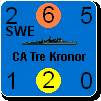hakon
Posts: 298
Joined: 4/15/2005
Status: offline

|
quote:
But I am more concerned with what the final product is. It seems to drift a bit too close to an RTS style of game (without the time constraints): "Attack there! Do it again!"
This reminds me a bit about a discussion we had earlier about giving the AI an advantage....
I guess that it maybe comes down to style of play. I like to focus on the long-term play, rather than who can play more quickly without making mistakes. Consequently, I play quite slowly, trying to make sure that I dont make any tactical mistakes. (Again, I really hate it when games get decided by a few tactical mistakes.) I never play with a clock - that would take the enjoyment out of it for me, as THAT feels like a RTS for me. (I prefer WC3 when i want to play RTS's.)
In my opinion, the most fun part of the game is being able to plan ahead. At least several impulses, but also several years. If I play Germany, I know exactly in 1939 how many armor, mech, lnd and fighters I want north and south of the pripet's during barbarossa, and if barbarossa will come in 1941 or 1942. I will then adjust these plans according to losses and enemy builds. Drastically, if I have to, but usually only by a few units. I never build a unit just because it is "cool", it always has a purpose, and is part of my long term strategy.
When planning my land attacks, I go through the following steps (not neccessarily in that order):
1) Before I take any actions (even air). I evaluate possible attacks vs the entire enemy front, determining where I can blitz, and what kind of odds I can get.
2) I then identify any points in the enemy front that can be put out of supply by any reasonable attack, and if additional attacks (or overruns) can be made against those out of supply units (if any).
3) After identifying all possible attacks, I consider the positional advantage (both tactial and relative to my long term strategy) I am likely to gain from each possible target, and weigh this against any material advantage I may gain/loose (including chance of flipping).
4) After evaluating possible gains, I consider what effect a very poor roll will have on my front. Can I afford to loose 2 units and flip everything. This is weighted against the likelihood of such a poor roll.
5) I will then ground strike any hexes i deem vulnerable or important, either for direct attacks, follow-up attacks, or as a counter-measure vs counter-attacks, if I have available air missions and sufficient air power.
6) After ground-striking, I re-evaluate 1-4, if neccessary, before moving my units and calling any attacks, adding HQ support, ground support, etc.
To me, the first of these steps is the trivial one. Though still quite time consuming, that step is very straight forward, and given enough time, anybody will be able to perform this quite accurately. Imo, the challenges lie in steps 3 and 4, especially when faced with having to compromize between short term and long term gains and losses and between possibility and risk.
For other people, especially people that like to play very quickly (RTS people in my opinion), emphasis on being able to perform step 1 very quickly and accurately becomes one of the most important aspects of the game, as a few serious mistakes during that step can cost the game quite quickly. These people are also the most likely to loose the game to a semi-competent AI, as beating the computer in terms of the speed of these calculations can be quite hard.
Anyway, implementing the kind of "odds view" that I proposed will remove some of the "trivia" for people like me that like to play slow games with emphasis on the long term strategy, while making it possible to disable the view (for both sides) should conserve the fun for the clock-using lightening-chess-wif-players out there.
I guess these things come down to budgets and priorities, and obviously, this kind of functionality is fully optional.
|
 Printable Version
Printable Version








 I did ask, didn't I?
I did ask, didn't I? 
 ).
).
 New Messages
New Messages No New Messages
No New Messages Hot Topic w/ New Messages
Hot Topic w/ New Messages Hot Topic w/o New Messages
Hot Topic w/o New Messages Locked w/ New Messages
Locked w/ New Messages Locked w/o New Messages
Locked w/o New Messages Post New Thread
Post New Thread